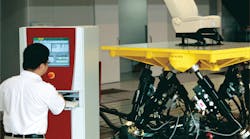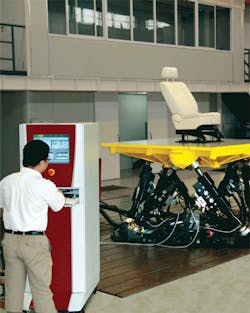Exova Group Ltd. provides demanding, laboratory-based testing and related advisory services for a broad range of products and processes. Test results ensure a customer’s compliance with safety and quality standards. Steve Panter, operation manager of global automotive testing at Exova, purchased a hydraulic simulation table last year from Moog Inc., East Aurora, N. Y.
Moog is a global designer, manufacturer and integrator of precision control components and systems. Moog designs and manufactures the servovalves, actuators, test controllers, and software used as an integrated system in the simulation table, which uses six Moog hydraulic test actuators configured into a hexapod assembly.
Lots of power, small footprint
As with conventional orthogonal test tables, the hexapod assembly achieves six degrees of motion, but in a much smaller envelope. The hexapod assembly pairs up the six cylinders into three triangular configurations. Each cylinder has a bore of 99 mm with an 80-mm diameter piston rod and working stroke of 8 in. Nominal flow from the 300-hp HPU is 60 gpm.
The simulation table is rated for payloads as high as 680 kg (1500 lb) while providing frequency response up to 100 Hz. Automobile makers and independent test houses can use this latest simulation table to replicate real-world road conditions that strain automobile components, such as axles, engines, interior and exterior assemblies, seats, steering column assemblies, cooling module systems, truck and tractor cabs, and after-treatment systems for heavy-duty diesel applications.
“As our customer uses the simulation table for more tests, some features clearly emerge as key advantages. First, higher fidelity means a more realistic test,” stated Tobe Ehmann, Moog’s product line sales manager for test and simulation. “Second, compared to classic orthogonal systems, the hexapod has a smaller footprint, just a third the size of classic systems, which creates more floor space for the user.” At 100 Hz, the table’s response far exceeds published ratings of 50 Hz for orthogonal tables. Of course, when moving higher or lower payloads, the response of either design will be lower or higher, respectively.
Exova’s Panter, stated, “A lot of damage occurs within the range from 50 to 80 Hz when a company does testing analysis. With a lower performance simulation table, results are often filtered down to 40 Hz, so any damaging events beyond that point are not captured. The Moog Hydraulic Simulation Table allows those events to be included in the scope of testing and broadens the value of the testing process.”
Ehmann added, “We use a hydrostatic bearing hydraulic test actuator in our new simulation table because it is robust and gives high performance. We have designed, developed, and manufactured our own actuators.”
Accounting for side load conserves energy
Although traditional cylinders use a 4-pocket bearing design, Moog developed an innovative 8-pocket hydrostatic bearing design, which improves side load test capabilities. Ehmann explained, “Traditional 4-pocket cylinders can withstand side loads up to 40% of stall, but Moog’s new 8-pocket design withstands side loads up to 60% of stall, which increases your test capabilities significantly. And these higher forces can be reached with less leakage flow, thus using less oil with lower maintenance. In addition, our new hydrostatic bearing actuator requires a smaller HPU, making this essentially a cleaner hydraulic application over traditional designs.”
Improved dynamics, reliability
Moog has developed actuators and other motion control components for some of the world’s most demanding applications. Ehmann continued, “Actuators are key to high performance test solutions. Test facilities need reliable, high performance components. Our new hydrostatic bearing hydraulic test actuator is a benchmark for strength and durability test applications. We can improve the performance of today’s test systems while simultaneously meeting stricter environmental concerns.
“We made significant improvements developing a better cushioning system. The cylinder incorporates this design to ensure safety and prevent equipment damage. The 086-6 series actuator has a cushion at each end to ensure that the piston will be decelerated before reaching end of stroke in both directions.”
Benefits of the cushioning include:
• damping force provides reliable and repeatable testing,
• each cushion design is physically tested to ensure proper operation, and
• true active cushioning in a sealed system.
The cylinder also has a coating on the piston rod to significantly reduce seal wear for long life and less maintenance. A stainless steel rod utilizes proprietary seals and this unique rod coating to provide several performance advantages, including:
• rod surface hardness 80 HRC.
• clean operation allows for less maintenance time and costs.
• proprietary surface finishing requirements enhance seal life and minimize oil leakage.
• stainless steel rod resists corrosion.
This design also provides for a cleaner hydraulic operation creating a more environmentally friendly lab.
Moog engineers also designed a manifold to house all of the piping to the cylinder, thereby removing the need for most exterior plumbing and its associated maintenance and potential leakage. The results are fewer maintenance requirements and less downtime.
For more information on Exova’s testing service and other capabilities, visit www.exova.com.
For more information Moog’s servocylinders and other components and services, visit www.moog.com.


